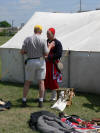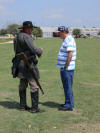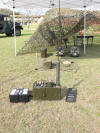| Event: | Muster Day |
| Date: | April 1-2, 2006 |
| Location: | Camp Mabry - Austin , Texas |
| Description: |
During the two-day Muster event on April 1-2, 2006, volunteers from the Lone Star Military Vehicle Preservation Association, augmented by jeep owners from reenacting organizations, moved the public from the museum area down to the battlefield and back. For lack of a better name, this aspect of the Muster was dubbed the “Lone Star Express” or simply the “Jeep Taxi.” Initially, the routes varied somewhat, and over the course of the weekend it was necessary at times to adjust the route on individual runs due to a number of variables including traffic concerns, unexpected pick up of “lost” members of the public, the need to expedite the process due to lines of people waiting in the heat, and the need to facilitate breaks for drivers. Ultimately, the typical loop turned out to be roughly one mile. The most frequently used route ran from the chapel parking lot (Bldg 78) on Saturday and from the parking lot of Building 82 across the street from the museum (Bldg 6) on Sunday. The loading point at the top of the hill was changed on Sunday to make the service more visible and increase crowd awareness. This change had the desired results. From either start point, the standard route was a half mile drive north down the backside of the museum through the armor and artillery displays and past the reenactor parking lot turning left at the end of the chain link fence across from the back of Building 14 where the paved road forms a triangle intersection. It then continued on the hard top down to the dirt road that starts at the picnic area. The route then went south for two-tenths of a mile over what can best be described as the lower jeep road to the disembark point where the road intersected with the east-west stretch of hard top adjacent to the allied lines. This main dirt road was the same one used for moving the Sherman and the half-tracks to and from the battlefield area. After disembarking passengers, drivers then loaded up returning attendees, turned left, and went a little over a tenth of a mile up the paved hill road to the armor display, and then over the main roads to the original loading point which amounted to just under two-tenths of a mile. Some variations of this route included south-north runs over the dirt track that winds through the old obstacle course and connects up with the third dirt road which starts from the hill road and parallels the main dirt road and the obstacle course road. It then runs down through the trees and comes out onto the main dirt road used by the heavy vehicles – the same road previously mentioned which formed the extreme western leg or bottom part of the triangle route leading to the battlefield. This variant was typically used when the foot traffic on the paved hill road was heavy right after the battle, when faced with oncoming privately owned vehicles (POVs) on the hill road, as an interesting diversion for participants who wanted a more adventurous route when the vehicles were not in great demand, and to break the monotony for drivers. Turnout of vehicles for this service was lower than expected and can be attributed to a number of factors. There were several competing events including a major reenactment the weekend before and one in conflict on the same weekend as the Muster at a location several hours north of Austin. Both are thought to have tapped out drivers and vehicle owners. For both days, there were six jeeps, one with a trailer. These vehicles formed the core of the Lone Star Express. There were an additional four jeeps tied into the battle which were used periodically as well. Without access to the lower road, deemed off limits for ecological reasons, moving large trucks was considered impractical especially given safety factors related to the need to share the road with foot traffic and the steep incline on the way up from the battlefield. Of the jeeps that did run, two or more were in almost constant operation from 0900 to roughly 1600 on both days. For the cadre of drivers who made up the backbone of this operation, conservative estimates put the number of one-mile loops run on each day in the range of 30 to 50 depending on loading and unloading times, minor route variations, traffic, and the number of breaks taken by the drivers. Most of the drivers took only a few minutes to hydrate between runs or make head calls. Similarly, lunch breaks were very limited, sometimes skipped entirely, and when taken lasted usually only fifteen to twenty minutes. Drivers involved were Danny K, Mike G, Rick H, John K, Glen V, Jeff M, Martin G, and Tim W. In addition, Chuck B ran the medic jeep on an impromptu basis when there was clearly a need. On Day 2, Jeff L and John K coordinated loading and unloading at the bottom of the hill. Right after the battle on Sunday, Jeff L was a particularly useful in a public relations effort by giving an explanation to members of the public who were impatient and vocal due to the heat and the necessary wait time. His explanation was helpful when he announced that the service was uncompensated, used privately owned vehicles at the expense of the drivers, and was provided solely as a courtesy and community service. Another interesting development was the need for someone to help with the Hetzer so that it could avoid the crowd. LSMVPA member, Rory C, was asked to assist in this capacity and though recruited at the last minute, he did so effectively.The overall approach was a good one. The primary purpose was to provide the public with a first-hand WWII vehicle experience. The secondary purpose was to move and assist veterans, elderly, disabled, children, and parents with kids in tow. These purposes were met. The comments from the public reflected the positive impact of this component of the Muster. Judging by input to the drivers, those just looking for a WWII vehicle experience had their expectations met and exceeded. Similarly, those that needed a ride due to age, disability, heat exhaustion, or overseeing children found the service to be of great benefit. As people movers, the arrangement was successful to a great extent, but certainly marginally so if the expectation was to move people in large numbers at a time. Limitations related to vehicle characteristics, road conditions, and road access were to be expected. Adjustments can be made to improve this aspect of the event and maximize the benefit of having military vehicles available to provide this service. |
To assist in reducing download time, Thumbnail pictures are below - simply click on the picture to see an enlarged version. To return to this page, use your Browsers BACK button.















